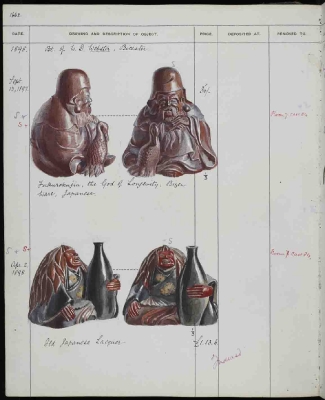To search the RPR site click here
Comparison of continental breakdowns between collections
The Pitt Rivers Museum normally uses a broad continental breakdown for all its objects and this will be used for these statistics. It includes Africa, the Americas, Asia, Australia and Oceania, and Europe.
Pitt-Rivers' founding collection
Africa = 1783 [9 per cent]
Americas = 1746 [8.8 per cent]
Asia = 2952 [15 per cent]
Australia & Oceania = 1711 [8.7 per cent]
Europe = 11426 [58.2 per cent]
Pitt-Rivers' second collection
Here is the breakdown for the second collection of all objects between continents [1]:
Africa = 2829 [13.8 per cent]
Americas = 1041 [5 per cent]
Asia = 3352 [16.4 per cent]
Australia & Oceania = 1460 [7.1 per cent]
Europe = 11304 [55.3 per cent]
Commentary
The first thing that strikes the reader when comparing the continental breakdowns for the two collections is that the percentages of European objects is very high, and very similar. Obviously the fact that Pitt-Rivers was based in Europe increased his ability to collect objects from this continent. [1] In addition, his interest in British archaeology probably influenced this. As will be seen elsewhere in the statistical analysis, many of the European objects are actually from the UK, and most of those are archaeological. There are many reasons for this dominance but one must be that it is cheaper to obtain local goods rather than to travel and buy elsewhere, or import, and the second is that stone tools and pottery sherds tend to cost very little but amount to many thousands of artefacts.
There are a greater number of African artefacts in the second collection (nearly 14 per cent as against 9 per cent in the founding collection). This reflects Pitt-Rivers' growing interest in Egyptian archaeology and also his ability to purchase these more expensive archaeological finds. He took advantage of his 1881 short trip to Egypt to purchase items for his collection.
There are fewer items from the Americas in the second collection than in the founding collection. The reason for this is not yet clear. Conversely the proportions of Asian and Australian / Oceanian objects remain more or less the same between the two collections at around 16 per cent and 8 per cent respectively of the total.
AP, 25.5.2010
Notes:
[1] He is thought to have only left the continent three times for short periods. In 1854 he served in the Crimean War, and in 1861 he travelled to Canada, both as part of his Army duties. Finally, inMarch 1881, he travelled on a Cook's tour to Egypt. None of these visits lasted more than a few weeks.




